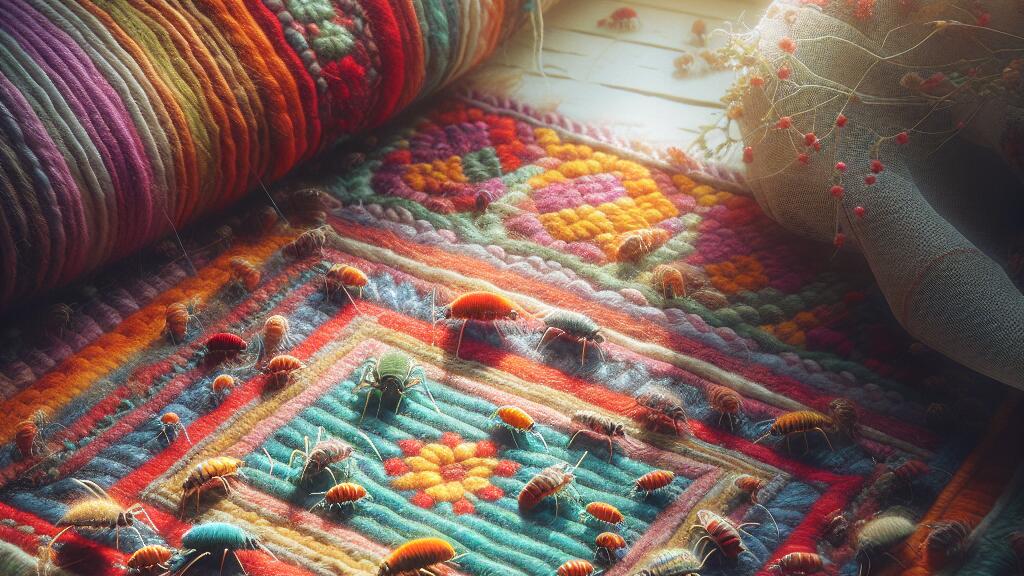
Table Of Contents
Preventative Measures for Wool Rugs
Choosing the right location for your wool rug can help minimize the risk of bug infestations. Avoid placing rugs in damp or humid areas. High humidity can attract pests like moths and carpet beetles. Instead, consider positioning your rug in well-ventilated spaces with ample sunlight. Bright light acts as a deterrent for many insects.
Regular maintenance is essential to keep your wool rug bug-free. Vacuuming once a week will help remove dust, dirt, and any potential larvae or eggs. Additionally, consider using a wool-safe spray that repels pests without damaging fibers. Rotating your rug periodically can also help distribute wear and minimize areas that may attract bugs.
More tips and tricks can be found here.
Tips for Keeping Rugs Bug-Free
Maintaining cleanliness is essential for preventing bug infestations in wool rugs. Regular vacuuming helps remove dirt, dust, and other debris that might attract pests. Use a vacuum cleaner with a beater bar to get deep into the fibers. Be sure to pay attention to edges and corners, where particles can accumulate. Additionally, consider using a rug pad underneath to improve airflow, which reduces moisture retention and creates an environment less favorable for bugs.
Proper storage of wool rugs can also deter unwanted pests. When not in use, store them in airtight containers or bags. Before storing, clean the rugs thoroughly to eliminate any potential food source for insects. Cedar blocks or mothballs can be placed in storage areas to provide extra protection against pests. Ensure that the storage space is dry and well-ventilated to prevent mold and moisture buildup.
Cleaning Techniques for Wool Rugs
Maintaining the cleanliness of wool rugs requires specific techniques to preserve their texture and appearance. Regular vacuuming is essential, as it removes dirt and dust that can potentially attract pests. Utilizing a vacuum with a gentle brush head is advisable to avoid damaging the fibers. For deeper cleaning, wool rugs benefit from spot cleaning. Blotting spills immediately with a clean cloth can prevent stains from setting in.
When it comes to thorough washing, a gentle approach is crucial. Washing wool rugs in cold water using a mild detergent ensures the fibers remain intact. Avoid harsh chemicals, as they can cause color fading or damage the wool. After washing, it’s important to air dry the rug flat, avoiding direct sunlight that can lead to shrinkage. These cleaning techniques help maintain a healthy and bug-free environment for your wool rugs.
Effective Methods to Remove Bugs and Debris
Regular vacuuming is one of the most effective ways to keep wool rugs clean and free from bugs. Use a vacuum with a brush attachment to gently lift dirt and debris without damaging the fibers. It's important to focus on the edges and corners where dirt tends to accumulate. For deeper cleaning, consider using a rug beater or shaking the rug outdoors to dislodge any hidden insects and dust particles.
In addition to vacuuming, spot cleaning can help eliminate stains and pest residues. A mixture of mild detergent and water can be used to treat small areas. Apply the solution with a soft cloth, then blot the area to avoid overwetting. For more persistent bug infestations, utilizing natural repellents like essential oils can offer a non-toxic option. Always ensure the rug is dry before placing it back in its original spot to prevent mold growth.
Professional Pest Control Options
When facing a persistent bug problem with wool rugs, enlisting the expertise of professional pest control might be necessary. Specialists are trained to identify the specific type of pests infesting your rugs and can provide tailored solutions. They often use eco-friendly treatments that are safe for delicate materials while effectively targeting bugs that may be hiding in the fibers.
Additionally, professionals can offer valuable advice on preventive measures to avoid future infestations. Their knowledge extends beyond immediate extermination, as they can educate homeowners about the best practices for maintaining a pest-free environment. Regular inspections by pest control experts can also help catch potential infestations before they become serious problems, ensuring your wool rugs remain a beautiful addition to your home.
When to Call in the Experts
When dealing with a severe bug infestation in wool rugs, it may be time to seek professional help. Signs of extensive damage may not always be apparent, and experienced pest control specialists can conduct thorough inspections. Their knowledge of the specific types of pests that target wool can guide effective treatment options that may not be easily accessible for homeowners.
Additionally, professionals utilize specialized equipment and treatments that are both effective and safe for your rugs. If previous attempts at DIY pest control have failed or if the infestation has spread to other areas of your home, reaching out to experts can provide a comprehensive solution. This proactive approach will help ensure the longevity and integrity of your wool rugs.
FAQS
Do wool rugs attract bugs?
Yes, wool rugs can attract bugs, particularly moths and carpet beetles, which are drawn to natural fibers like wool.
What can I do to prevent bugs in my wool rugs?
Preventative measures include regular vacuuming, using natural repellents, and maintaining a clean environment to deter bugs from nesting in your wool rugs.
How often should I clean my wool rug to keep bugs away?
It’s recommended to clean your wool rug every 6 to 12 months, depending on foot traffic and exposure to dirt, to help prevent bug infestations.
Are there specific cleaning techniques I should use for wool rugs?
Yes, use a gentle vacuum with a brush attachment, spot clean with a mild detergent and water, and avoid using harsh chemicals that can damage the fibers.
When should I consider calling a professional pest control service for my wool rugs?
If you notice a significant infestation of bugs that you cannot manage with DIY methods or if you want a thorough inspection and treatment, it’s best to call in the experts.